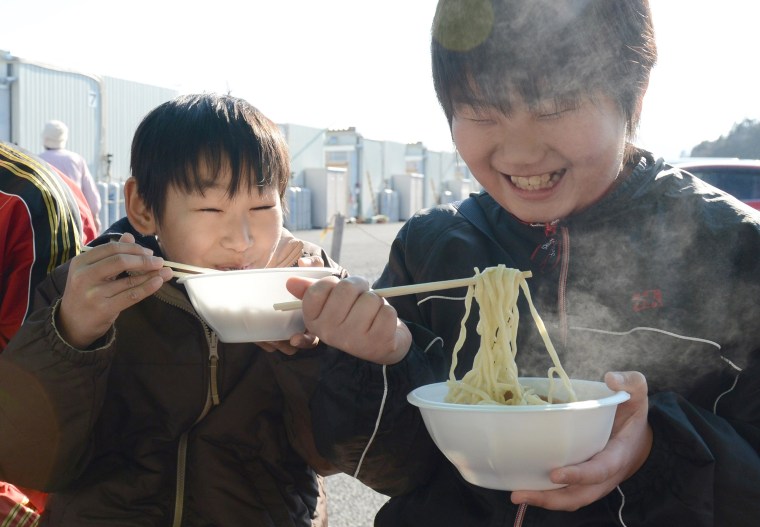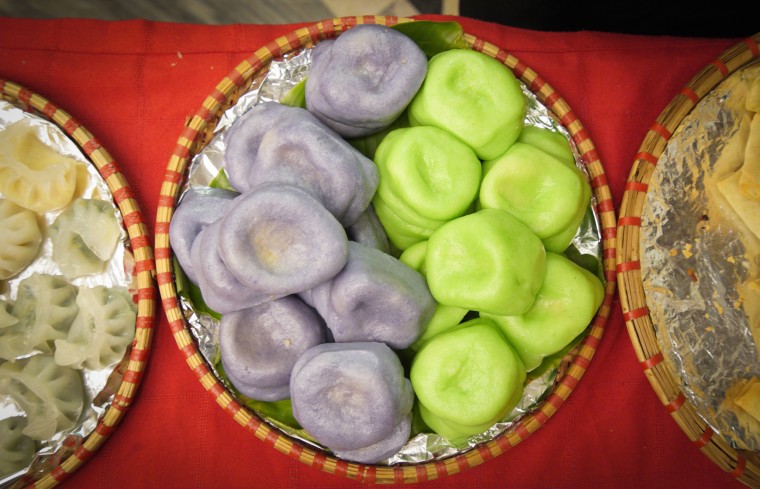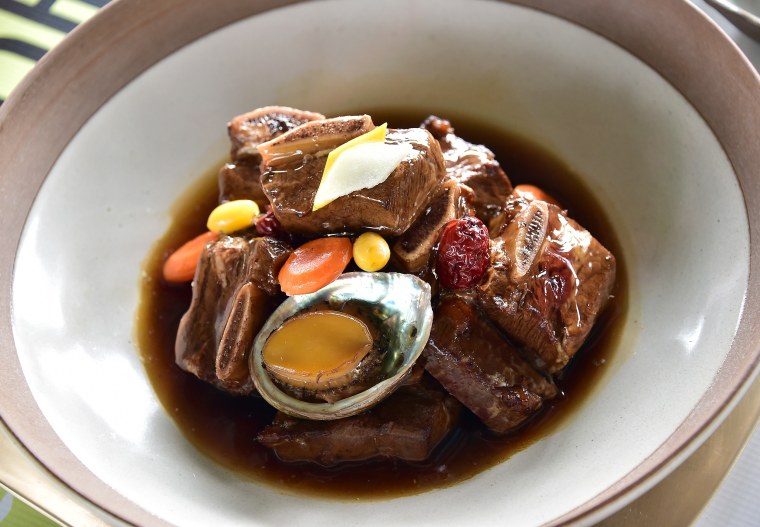Whether it’s Losar in Tibet, Tet in Vietnam, Seollal in Korea or Chinese New Year in China, Lunar New Year is celebrated in vastly different ways all across Asia and in Asian American homes in the United States. But there is one common theme: food! And usually lots of it.
Chinese New Year
Chinese New Year, also sometimes referred to as the Spring Festival in mainland China, is the biggest celebration in Chinese culture. There are several myths associated with Chinese New Year today, including the 12 zodiac animals, which are found in other Asian cultures but originate in China. For many who celebrate in the U.S., the day is filled with family reunions, food, “lucky money” in red envelopes and decorations.
Longevity noodles:

Long noodles, that should never be cut or broken, are widely consumed during holidays and life celebrations. The noodles are cooked in many different ways, from stir fry to broth, and each family has their favorite recipe, ranging from sesame to dandan. The key is to have noodles that are longer than normal and to be extra careful when preparing the dish at home.
Nian Gao, sticky Chinese New Year cake:
Originally used for ritual ceremonies, this sweet cake is important for New Year festivities. The pronunciation of the word sounds a bit like “year high” so many people believe that the dish will ensure a better year. The main ingredients are sticky glutinous rice, Chinese dates, sugar and chestnuts; the color can vary depending on where your family originated from in China. There are many modern variations to the dish like a nian gao made with red beans. Some families like to wrap up small pieces in wonton pastry and deep-fry them.
Yusheng or Lo Hei, raw fish salad
This dish is also called “Prosperity Toss” because people collectively stand around the table and use their chopsticks to toss the salad. The height of the toss reflects the fortune you’re going to amass in the New Year so the toss is usually enthusiastic and robust. There are many variations to this dish, including a vegetarian one, but the traditional and symbolic ingredients are strips of raw fish, a colorful array of shredded vegetables (carrots for luck, green radish for longevity, for example), a sauce (varies widely but usually involves a mix of plum sauce, sesame oil and water), and topped with condiments such as peanuts and sesame seeds.
Tangyuan, sweet rice balls:
Many people associate the shape of the sweet rice balls as family unity and believe the different balls in the bowl or plate as a representation of family. The rice balls are made with glutinous rice flour and water. They are served in a sweet soup after being cooked in boiling water or deep fried. The balls come in various sizes and can come on their own, unfilled, or filled with different sweet or savory pastes, such as black sesame seed and red beans.
Whole fish:
In certain Chinese dialects, the word for “fish” sounds like “surplus," so many people associate eating fish with New Year celebrations. The type of fish you decide to prepare is important as there are certain homophonic meanings associated with the name. But they are often prepared the same way -- steamed with soy sauce and ginger and topped with greens. The way you eat the fish is also symbolic and there are many traditions to adhere by, such as the head of the fish must be pointed toward the elders. Many people also believe it’s important to leave some fish behind for the next day, ensuring that the luck carries into the new year. The fish is so important that there are even Chinese New Year sayings that revolve around the fish.
Losar, Tibetan New Year
Losar celebrations are rooted deeply in Buddhist beliefs, and although many Buddhists practice a vegetarian lifestyle, many celebrate with the consumption of beef or yak. “Tashi delek,” which translates to “May good be with you forever,” is the common saying for the holiday.
Momo, Tibetan dumplings:

These Tibetan dumplings are packed with a hearty minced meat, filled with juice, and are considered a special treat reserved for holidays. To contain the juice, the dumpling skins are usually thicker and the best ones are homemade. There are a few ways to enjoy the momo, whether in a sauce or on their own, sometimes dipped in dab sepen, a Tibeten red chili paste. The momo is a labor intensive dish but a great way to come together in the kitchen to spend time with family.
Khapse or Khabsey, Tibetan “cookies:”
Khapse, which translates directly into “mouth-eat,” is kind of like a cookie. A widely loved, deep-fried pastry, the khapse comes in all shapes and sizes and is most commonly enjoyed on Losar. Using flour, butter, eggs and sugar, the dough can be folded, braided, and shaped into symbolic shapes, like donkey ears and lotus flowers. The larger khapses are often used as shrine offerings and decorations. They can easily be prepared at home but the khapse is a true art form and larger families depend on a khapse chef to do the honors. Khapse are commonly enjoyed dipped in Tibetan sweet tea.
Guthuk, Tibetan New Year’s Eve soup:
Guthuk, a hand-rolled noodle soup dish, is usually consumed two days prior to the start of Losar. “Gu” translates to nine, so it is often accepted that the dish is composed of nine different ingredients but of course, this varies by family. It is believed that the consumption of this dish helps cleanse negativity and dispel bad spirits. Families will often gather around the Guthuk pot and each member will pull out a ball shaped dumpling. Inside the dough, there is a piece of rolled or folded piece of paper with a human character trait that is supposed to reveal a divination of sorts. It’s often playful but a great way for individuals to reflect for the year ahead.
Tet, Vietnamese New Year
Tet, which is shortened from Tết Nguyên Đán, is considered by most Vietnamese to be the biggest Vietnamese holiday. The day marks the first day of Spring and celebrates the new year. Families come together to eat, pay respects to ancestors, receive and give “lucky money” in red envelopes, and give gifts. Tet coincides with other major Lunar New Year festivities celebrated around the globe.
Xôi Gấc, red sticky rice:

The Xoi Gac is a symbolic dish because of its unique and vibrant color, a bright red with hints of orange. The color comes from gac, a baby jackfruit, a fruit that is usually hard to come by outside of Asia. Many people often opt for frozen gac when the fruit is hard to find. The fruit itself is bitter, so the rice is prepared with coconut milk and sugar, giving the final dish a sweet taste. The color red often represents luck and fortune in Asian cultures giving this dish even more importance.
Bánh Chưng, Vietnamese rice cake:
The Banh Chung is probably the most popular Tet dish. The savory sticky rice dish, shaped as a square, is traditionally filled with mung beans and pork and cooked in banana leaves. The green, squared shaped dish has a long history tied to a prince and many Vietnamese families still continue to practice the traditions of making it at home. They can also easily be purchased at local Vietnamese markets. Due to its color, shape, and symbolic importance, many believe the dish symbolizes the earth, and it is often used as an offering on ancestor worship altars. The dish is quite heavy, so you will often find it served with pickled vegetables, its acidity helps balancing it out.
'Mứt Tết', traditional candied fruits:
There are dozens of variations of mut, preserved fruit and nut, but per its name, 'Mứt Tết’ plays an important role for many Vietnamese families during Tet. These sweets are often offered to guests when they arrive for Tet celebrations. There are a handful of different ways to prepare mut so you’ll find them in jam-like textures or even candied. They can be made with ginger, coconut, lotus seeds, rose petals, white squash, and more so the possibilities are truly endless.
Seollal, Korean New Year
Seollal marks the first day on the Korean calendar. Korean American children will often dress in hanbok, traditional Korean dress, and do a formal bow to receive money from elders. For families who still practice ancestor worship, there is an added layer of charae, ancestral rites and worship to the new year festivities. Seollal, like Tet, coincides with other Lunar New Year festivities around the globe.
Tteokguk, Rice Cake Soup:
This is by far the most important dish to ring in the Korean New Year. Tteokguk, rice cake soup, is usually made with beef or anchovy broth, beef chunks, thinly sliced rice cake (traditionally cut from a long rice cake, length representing longevity), egg whisked in. Or if you want to do extra work, make an egg as al-gomyeong -- think omelette strips as garnish -- and top it with chopped scallions, seaweed strips and sesame seeds. This dish symbolizes turning a year older and the consumption of it on New Year's Day is culturally believed to bring longevity, good health and fortune.
Galbi-jjim, Korean Braised Short Ribs:

This popular celebratory dish was historically reserved for the wealthy class or special occasions. Today, at most Korean celebrations, this dish is the highlight. The meat is cooked for a long duration, ensuring the perfection absorption of sweet and salty marinade and meat that melts on the tip of your tongue. The secret to a great galbi-jjim marinade is the use of a fruit. An Asian pear works best but a sweet apple will suffice. Although the main ingredient is the short ribs, the dish wouldn’t be complete without all the other stuff like mushrooms, carrots, jujubes, and chestnuts.
Jeon, “Korean Pancake” Dishes:
A staple for Korean ancestor worship offerings, jeon dishes are commonly consumed during the major Korean holidays, including Seollal. There are dozens of variations, from haemul pa-jeon, a seafood scallion pancake, to kkaenip-jeon, perilla leaves stuffed with meat. What makes a Korean pancake a pancake is the thin batter that’s gently fried. Most Korean Americans who celebrate New Year will remember the plastic tubs filled with jeon in the refrigerator for the days that follow.